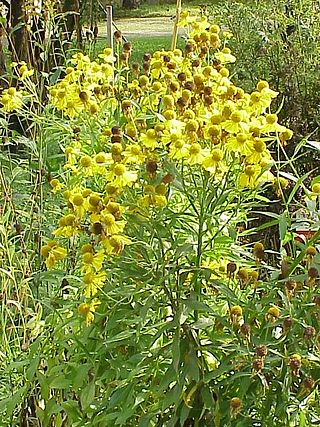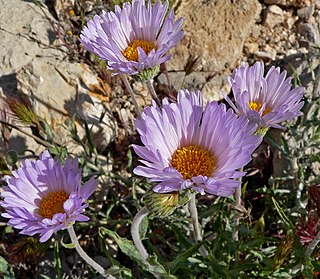
Helenium autumnale is a North American species of flowering plants in the family Asteraceae. Common names include common sneezeweed and large-flowered sneezeweed.

Ageratina shastensis is a species of snakeroot which is endemic to Shasta County, California. It is known by the common names Mt. Shasta snakeroot and Shasta eupatorium.

Chaenactis is a genus of plants in the family Asteraceae which are known generally as pincushions and dustymaidens.

Eupatorium altissimum, with the common names tall thoroughwort and tall boneset, is a perennial herbaceous plant in the Asteraceae family with a native range including much of the eastern and central United States and Canada. It is a tall plant found in open woods, prairies, fields, and waste areas, with white flowers that bloom in the late summer and fall.

Xylorhiza is a genus of flowering plants in the family Asteraceae, known as woodyasters. These are daisylike wildflowers usually having blue to purple or white ray flowers with yellow centers of disc florets. Woodyasters are native to western North America.
Blepharipappus is a North American plant genus in the family Asteraceae containing the single known species Blepharipappus scaber, known by the common name rough eyelash, or rough eyelashweed. Blepharis is Greek for 'eyelash' and 'pappus' refers to the feathery part of the plant's seeds.

Cirsium occidentale, with the common name cobweb thistle or cobwebby thistle, is a North American species of thistle in the family Asteraceae.

Erigeron aphanactis is a species of flowering plant in the family Asteraceae known by the common name rayless daisy, or rayless shaggy fleabane. This wildflower is native to the western United States, primarily the Great Basin and Colorado Plateau regions.

Erigeron compactus is a species of flowering plant in the family Asteraceae known by the common names cushion daisy, fernleaf fleabane, and compact daisy.

Ageratina herbacea is a North American species of flowering plants in the family Asteraceae known by the common names fragrant snakeroot and Apache snakeroot. It is native to desert regions of the southwestern United States and northern Mexico. It grows in rocky slopes in conifer forests and woodlands.

Arnica sororia is a North American species of flowering plant known by the common name twin arnica. It is native to Western Canada and the Western United States. It grows in grasslands and in conifer forests, as well as the sagebrush steppe.

Symphyotrichum ascendens is a species of flowering plant in the family Asteraceae known by the common names western aster, long-leaved aster, and Rocky Mountain aster. Blooming July–September, it is native to western North America and can be found at elevations of 500–3,200 m (1,600–10,500
Balsamorhiza macrolepis is a species of flowering plant in the tribe Heliantheae of the family Asteraceae, known by the common name California balsamroot. It is found only in California, where it grows in dry, open habitat, mostly in mountainous areas, mostly in the western foothills of the Sierra Nevada and in the eastern Coast Ranges near San Francisco Bay. It is now becoming rare in the Coast Ranges.

Balsamorhiza sagittata is a North American species of flowering plant in the tribe Heliantheae of the family Asteraceae known by the common name Arrowleaf Balsamroot. It is widespread across western Canada and much of the western United States.

Crepis modocensis is a species of flowering plant in the family Asteraceae known by the common name Modoc hawksbeard.

Crepis occidentalis is a North American species of flowering plant in the family Asteraceae known by the common names western hawksbeard, or largeflower hawksbeard. It is native to western Canada and the western United States.

Dieteria canascens is an annual plant or short lived perennial plant in the family Asteraceae, known by the common names hoary tansyaster and hoary-aster.

Ribes cereum is a species of currant known by the common names wax currant and squaw currant; the pedicellare variety is known as whisky currant. The species is native to western North America.

Ageratina luciae-brauniae is a species of flowering plant in the family Asteraceae known by the common names Lucy Braun's snakeroot and rockhouse white snakeroot. It is native to the eastern United States, where it is limited to the Cumberland Plateau of Kentucky and Tennessee. It may also occur in South Carolina but these reports are unconfirmed.

Symphyotrichum spathulatum is a species of flowering plant in the family Asteraceae native to western North America including northwestern Mexico. Commonly known as western mountain aster, it is a perennial, herbaceous plant that may reach 20 to 80 centimeters tall. Its flowers, which open in July and August, have violet ray florets and yellow disk florets.



















